Cover Story: Home and Lifestyle Modifications for Safety and Accessibility
 Written by
Written by
Maryann B. Hunsberger
Reviewed by
Jack Burks, MD
MSAA Chief Medical Consultant
Edited by
Susan Wells Courtney
I remember skipping down the stairs and leaping over the baby gate at the bottom with my hands full of laundry. Then I’d run down another flight of steps to the basement to fill the washer before sprinting back up with the wet sheets. With one arm full of wet sheets and the other grasping my son, I’d jump down the back steps and hang the sheets on the clothesline. And that was all before breakfast.
I never dreamed that a few years later, I’d be stranded on my front landing, unable to get down the two steps without holding onto my husband. I certainly never imagined that I’d get stuck in my bathtub, unable to stand up without my husband to pull me out.
Over time, I found solutions to some of the obstacles I was experiencing. Some remedies were not difficult. For instance, I learned that showering was easier than taking a sit-down bath. When the time came that I needed to sit while bathing, I purchased a shower chair at a medical supply store. When the single railing on our inside staircase became too difficult for me to navigate, purchasing a second railing at a home-improvement store was a simple fix. And while I was fortunate enough to have my husband install the railing, for anyone without a handyman at home, accredited handymen may be located by searching on the Better Business Bureau’s website at www.bbb.org.
Easy Solutions for Mobility Problems, Fatigue, and Other Impairments
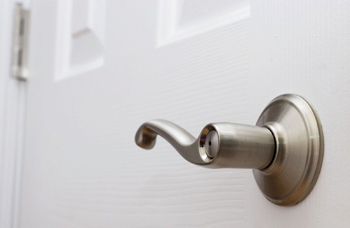
A lever-type door handle can be operated with an elbow or a fist if needed.
Resolving an accessibility problem is often easy with just a few changes. Shelley Peterman Schwarz devised many solutions for different accessibility problems and put them into a book, Home Accessibility: 300 Tips for Making Life Easier. Schwarz says some of her favorite solutions are ordinary products from home-improvement stores. Door handles with a lever instead of a knob, and rocker light switches that toggle on and off, are two examples. “These items aren’t made for people with disabilities, but they make life easier. A lever door handle can be opened with an elbow or a fist. It’s the same for rocker light switches – hand strength isn’t required to turn them on or off. Touch lamps, timers on lamps, and motion-activated lightbulbs can also help.”
For someone with mobility problems, moving or eliminating furniture to allow more room for a mobility device can help. Schwarz continues, “Arrange the rooms for your convenience. Forget aesthetics and the latest decorator trends. Take throw rugs, for instance. These can be dangerous to someone with a mobility problem. It’s better to get rid of them.”

A rocker or toggle-type of light switch is easier to operate and requires less dexterity than a traditional light switch.
Patricia Bobryk, MHS, PT, MSCS, ATP is a physical therapist who is certified as an Assistive Technology Professional (ATP) through the Rehabilitation Engineering Society of North America (RESNA). She explains that changing thresholds can be another easy fix. “When floor surfaces change from tile to carpet, people can catch their toes on these slight changes in floor level. A flatter molding or one that is more beveled can help.” Bobryk also notes that nonskid flooring works better than carpeting for someone in a manual wheelchair. While many may be familiar with this fact, considering these types of floors when planning home improvements is important.
Individuals with disabilities may be able to find solutions by modifying how they perform their normal activities. For example, some people might feel more stable if they hug the wall or lightly hold onto furniture when walking between rooms. One MSAA client found that she couldn’t get in and out of the bathtub to bathe in the evening because of fatigue and balance issues. Changing her bathing time to the morning, when she had the most energy, made a difference. The client was then able to bathe without making changes to the bathtub.
In homes with bathrooms on the main floor, some people move their bedrooms to the first floor rather than purchasing a stair lift if needed to reach a bedroom on the second floor. Once in the bedroom, another tip is to use foot-lifter straps to help get into bed with less effort. Foot-lifter straps may also be used to lift one’s legs to put on socks. And instead of straining to be heard by someone in another room, some people install baby monitors in certain locations throughout the house so they can easily be heard from any room.

Preparing food while sitting is a good energy-saving strategy.
Reducing Fatigue through Energy Conservation
Fatigue is a common issue for people with MS and other disabilities. As an occupational therapist, Kathleen Zackowski, PhD, OTR is trained to help people to modify how they do things so they can conserve energy and be safe. “Energy-conservation techniques allow a person to enjoy what they are doing without using up all of their energy. Learning how to cut corners lets a person still do things without becoming exhausted.”
Decreasing the total load is key to conserving energy, according to Zackowski, and this may be applied to many of one’s daily activities. For instance, when cooking, she recommends using a barstool to sit on while preparing food, which saves precious energy. A good idea is to select a barstool with a back to provide lumbar support. Another option is to use a sit-stand work stool that adjusts to various counter heights.
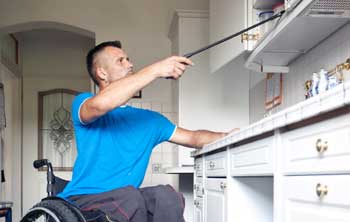
Using a “reacher” allows for easy access to items in hard-to-reach places, avoiding the need to ask for help or reconfigure the shelving.
Chopping food and making salads when seated at the table is also an easy change. Bobryk says, “Any activity you can do while sitting instead of standing saves 25 percent of the energy required. This also holds true for sitting to take a shower, and by doing so, you have more energy to do whatever is needed afterward. When cooking, a good tip is to keep a crockpot within easy reach. This is a great energy saver and you can throw all of the ingredients in at once.”
Schwarz reminds people that tasks can be broken up into smaller segments. “You don’t need to do everything at the same time,” she states. “Modifying or even postponing certain tasks to conserve energy can often reduce or eliminate the need for expensive modifications.”
One of the easiest fixes in the kitchen is to have everything at eye level. Bobryk states that this can be accomplished by changing the locations of things. “Keep the things that you use frequently at arm’s reach instead of up too high or down too low.” Shelves that slide out work well, too. They can be purchased online and used in existing cabinets. Extension shelves with drop-down cabinetry can be purchased at home-improvement stores. “Reachers” or “grabbers” are inexpensive and can assist with accessing various items when not able to put everything within reach. These can be purchased at any pharmacy or medical supply store.
Easy Solutions for Temperature Sensitivity
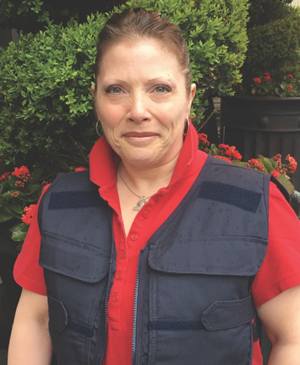
Cooling accessories such as this vest provide symptom relief for heat-sensitive people. MSAA’s Cooling Distribution Program provides free vests to individuals with MS who qualify.
Temperature sensitivity can be a problem for people with MS, and kitchens get hot when cooking. Wearing cooling vests and other cooling accessories can help in the kitchen. “If it’s too humid where you live, evaporative cooling accessories won’t work as well, so add ice packs in the vest,” says Bobryk.
Induction plates, which are portable cooktops with ceramic tops, keep kitchens cooler. Induction plates heat through magnetic conduction versus a heating element or a gas flame – so the surface does not get overly hot – but only certain types of cookware will work with induction plates. Larger toaster ovens and microwaves may often be used instead of the oven, and these generate less heat as well. Cooking earlier in the day can also help. “By evening, your energy is lower and you are more prone to be bothered by the heat. Preparing food in the morning when it’s cool, and reheating the food in the toaster oven or microwave at dinnertime, is a good strategy.”
For the person with both temperature sensitivity and fatigue, Wi-Fi thermostats save steps by allowing for remote programming. Once a smart thermostat is synced with a Wi-Fi router, remote access is available from a computer, tablet, or smartphone app. A smart thermostat and Wi-Fi router can be found online or at home-improvement stores.

Today’s technology allows for individuals to control lights, temperature, security systems, and other devices through their smartphone.
A Wi-Fi thermostat can stand alone or be part of a larger home-automation system that is run by a single app. For example, kits combining a Wi-Fi thermostat, hub, wall switches, and outlets allow lamps and appliances to be operated by a smartphone. Home-improvement stores and online vendors also carry these additional products. Some can even be interfaced with a smart-speaking device, so lowering the heat can be as simple as saying, “Lower the heat to 70 degrees.”
Easy Solutions for Visual Impairments
The most important factor for someone with visual impairments is to have clear paths with no clutter to trip over. Colorful reference points also help. Adding a contrasting border to carpet, wood, or tile floors around the edge of the room can provide a good visual cue. A differently colored walking path can show the way from room to room. Floor colors that contrast with furniture colors are also useful. Doorways and light switch plates in contrasting colors can be effective as well. Schwarz says that an inexpensive way to show contrast is to use painter’s tape. “Place it where the wall meets the floor. It’s designed to come off without stripping the paint.”
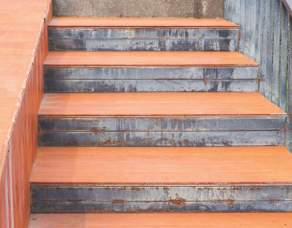
These steps illustrate how contrasting colors on the risers and treads of a stairway help to distinguish where each stair begins.
The use of contrasting paint on the risers of steps can make steps more visible (risers are the front panels that face you when walking up the steps). This color should contrast against the color of the top of each step, where your foot touches, and this part of the steps is referred to as the “tread.” Just be sure not to paint the tread of cement steps, since they can become slippery and dangerous.
Easy Solutions for Cognitive Impairments
Zackowski points out that many people with MS may experience cognitive changes, especially as individuals become older. Additional factors such as stress, depression, family issues, and a hectic schedule can also impact one’s memory and other cognitive functions. She advises, “Make lists instead of trying to remember everything. Doing so will become automatic after a couple months. While it takes time, having lists to refer to will make your life better.”
Smartphones and smartwatches come in handy for people with cognitive changes. With built-in timers, they can be used as reminders to take medication or to perform a necessary task. The calendars on these devices can be set for events, such as doctor appointments, and reminders will pop up on the screen or vibrate at the right time. Some smartwatches can be set to read these reminders aloud.
Certain smartwatches may also have medical alert components. At the push of a button, help is summoned. These watches come with a hub that operates by plugging it into a wall socket. These can be purchased online and at various retail stores.
MSAA’s mobile phone application, My MS Manager™, can also assist with reminders and record-keeping. It is available free of charge to individuals with multiple sclerosis (MS) or their care partner to use on their iPhone, iPad, iPod touch, or Android mobile phone device. My MS Manager™ allows members of the MS community to track disease activity, store medical information, and generate charts and reports across various metrics such as treatments, moods, symptoms, and more. For information, please visit mymsaa.org/mobile.
More Complex Solutions involving Steps, Ramps, or Railings

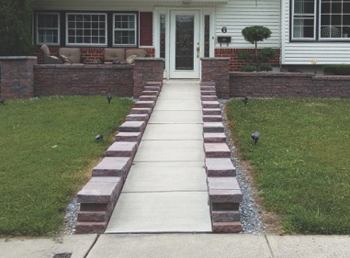
Landscape ramps such as this one are both functional and attractive.
One accessibility problem that stumped me was entering and leaving my home. Through connections I made with the disability community in my state, I was able to find a local Assistive Technology Professional (ATP). The ATP came to my home and spoke with me, asking me what I was having the most trouble with. I told him I couldn’t take my children to school, since I couldn’t climb down the front steps.
Since this individual was certified by the Rehabilitation Engineering and Assistive Technology Society of North America (RESNA), he was qualified to assess my situation and offer suggestions to keep me safe while providing independence. He told me that the dilemma with my front steps was partly caused by the steps not being made to state code, which has a maximum height of 7.75 inches. Two of my steps were 10 inches high. The step leading into the front door had an 11-inch rise, forcing me to hang onto the storm door closer (pneumatic cylinder) to pull myself into the house.
The ATP explained that he sometimes recommends wooden ramps for problems like these. Depending on the situation, he may recommend modular ramps, which are steel structures that, although not portable, are not permanent structures. These can be moved to a new home or can be placed inside garages, so the house won’t have a visible front ramp. The ATP noted that modular ramps also hold up to the elements better than wooden ramps. In other situations, he may recommend landscape ramps, which are made of cement and blend beautifully into the scenery. People who don’t want a ramp-like structure in front of their homes often prefer this solution.
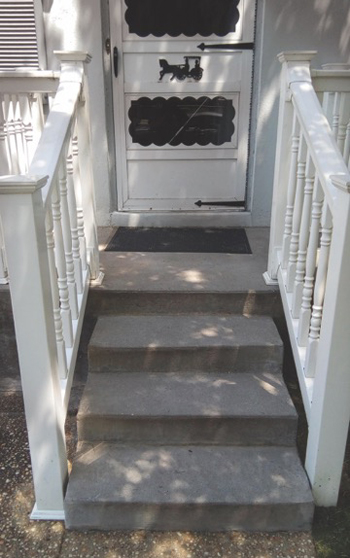
This article’s author was able to resolve her accessibility problems at her own home by replacing her tall steps with low-rise steps and a double railing.
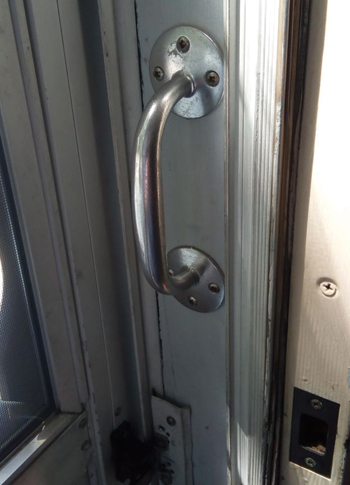
A 5-inch vertical grab bar was added to the doorway, which is very useful to help her to enter her home and feel safe.
When a house is too high for a ramp or has no room for one, the ATP sometimes suggests vertical platform lifts, either for outside or inside a garage. These lift a person in his or her wheelchair or scooter right up to the door.
Since I’m able to walk to my car, the ATP didn’t recommend a ramp. He explained that for every inch of rise, a foot of ramp is required to be compliant with the Americans with Disabilities Act (ADA). For instance, with a 7-inch-high rise, you need a 7-foot ramp. If you have a 21-inch rise, you will need a 21-foot ramp. This means that the ramp may need to wind around. Above 30 inches requires a landing. The landing needs to be big enough – 5 feet x 5 feet – to turn a wheelchair or scooter onto. Since my steps were 31-inches high, a 31-foot ramp with a landing would be required. Not only was that too much walking for me, but I didn’t want such a large structure in my front yard.
Instead, the ATP recommended low-rise steps with two railings. He suggested that I walk up and down some curbs to determine the height I’d be able to handle alone. I found that I was fine with a 5-inch-high curb, so I knew my steps should be that height. He also recommended railings on both sides of the steps. He said a handrail should be included, which is a separate rail that is usually attached to the inside of a railing. It is inset from the larger outside rails and provides a rail for holding onto that is typically lower, thinner, and easier to grasp. However, I ended up not getting these handrails added, although these could have been helpful.
The ATP explained that he sometimes recommends widening entry doorways for wheelchairs or scooters to go through. In my case, he recommended simply adding a 5-inch vertical grab bar between my front door and my storm door so I wouldn’t need to hang onto the storm door closer anymore. This small modification has made such a difference in my ease of entering as well as my feeling of safety.
I didn’t know how to find a contractor who was familiar with disability accommodations. Instead, I just chose the contractor who gave me the best price, which is not always the best plan. Since he was not familiar with disability accommodations, I needed to explain to the contractor what low-rise steps were. Even at that, he inexplicably thought I also wanted the stair treads to be small and wanted the steps to be narrow. The steps he began to construct looked like they were for toddlers. I had to remind him that I wanted wider steps with a normal stair tread (10-½ to 11 inches) so adults could use the steps.
In looking back, I found that I did some things right, such as hiring a RESNA-certified ATP to assess my situation and give me recommendations, and requiring the contractor to correct the stair width and tread size. However, I did some things wrong, such as hiring a contractor with no knowledge of disability accommodations and not insisting that handrails be added to the railing.

A handrail connected to the main railing is often recommended for easier gripping.
As my experience shows, finding a competent contractor is important. The Better Business Bureau’s website is a good resource for finding contractors who are licensed, insured, and experienced. At the same time, finding a contractor who knows about disability modifications is crucial. Bobryk suggests looking for a CAPS-certified (Certified Aging in Place Specialist) contractor. The website for the National Association of Home Builders (NAHB) at www.nahb.org provides a great deal of information on buying, maintaining, and remodeling homes. It also gives a list of CAPS-certified contractors on their website.
Bobryk also suggests interviewing contractors. “Ask how many accessibility designs they have done. Ask for pictures. Ask for certification in either accessible design or universal design. Universal design means the design will work for everyone, with or without disabilities.”
Modifications inside the Home
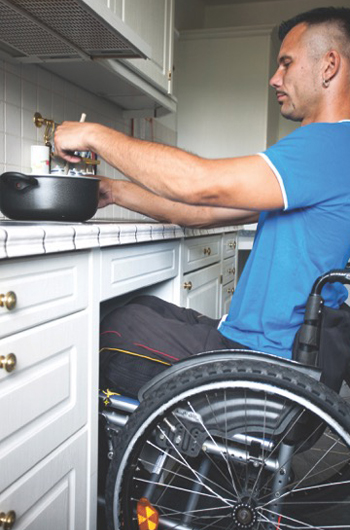
Removing cabinets from under a counter, sink, or cooktop can allow individuals to have easy access with a wheelchair.
If wheelchairs are needed, front entries are only part of the more costly solutions people with MS may need. For example, kitchens are fraught with obstacles. Bobryk suggests starting small. “You can do things piece by piece. Maybe start by lowering light switches and raising electrical outlets to wheelchair height.”
She says an existing sink can be made wheelchair accessible by removing the cabinet under the sink and leaving it open. The same can be accomplished with a stove by switching to a cooktop with an open space under it. “Make sure the cooktop knobs are in front. And switch to sink faucets that can be turned on by touching or waving.” Also, side-hinged wall ovens open like a regular door and allow for easier sliding in and out of food. Drawer dishwashers are easier to load and empty.
In some kitchens, a two-tiered countertop, where one counter is above the other, can be helpful. This example of universal design allows a person in a wheelchair to sit at the lower counter, while an ambulatory person can stand at the higher counter. This functions well for center islands. It also works well for people who fatigue too easily to stand while preparing food.
Bathrooms are the other inaccessible hot spot in most homes. Bobryk says, “The bathroom is a big issue that doesn’t always have an easy fix. If someone can’t access the bathroom, we need to call in professionals. But, ask the builder for pictures of other accessible bathrooms he or she built. Wheelchair users might need to lower towel bar height and buy a bathroom sink that is lower. Roll-in showers, walk-in tubs, and hydraulic lift tubs are options to consider.”
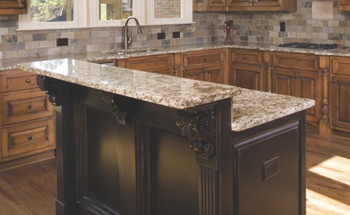
An example of universal design, a two-tiered countertop allows a person in a wheelchair to sit alongside the lower counter, while an ambulatory person can stand or sit at the higher counter.
Grab bars are important to help steady someone with balance problems. Bobryk notes, “They make them way more stylish now. The grab bar functions the same but doesn’t look like it’s for a disability. Home-improvement stores carry these more stylish grab bars.” Individuals may also go online to shop for aesthetic grab bars. Some websites will recommend local installers, and they may show diagrams and instructions for ADA grab bar requirements for shower stalls, bath tubs, and toilet stalls. Grab Bar Specialists is an online company that offers this type of information, which you can find on their website at www.grabbarspecialists.com.
Widening the bathroom doorway isn’t always necessary. Doors can be reversed to open out, giving more space to enter the bathroom. Regular doors can sometimes be switched to pocket doors that slide inside the walls. And offset hinges can be used to create more space. Bobryk says, “It’s an easy fix that lets the doors swing open behind the door jamb. It can allow for an extra 1-½ or 2 inches of space.”
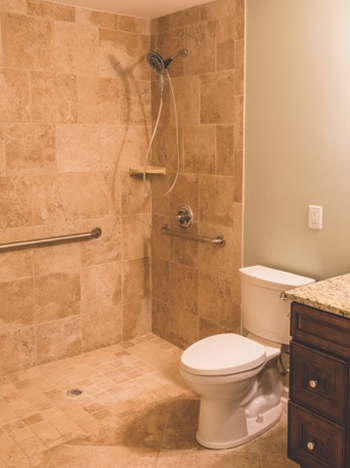
A roll-in shower is one option to consider when traditional showers or baths become challenging.
Many interior doors, such as those used for a bathroom, are only 24 inches wide. When widening a doorway is necessary, if the approach is straight, you will minimally need a 32-inch opening to accommodate a wheelchair. If the door is connected to a hallway and a turn is needed, a 36-inch opening is required. According to Adaptive Access, a national supplier of home-modification equipment and local contractor in Houston, Texas (www.adaptiveaccess.com), a number of steps are necessary to widen a doorway. These include removing the old door and trim; possibly moving a light switch; and cutting the wallboard and studs. Once the opening has been prepared, the new door and trim may be installed. These will need to be painted and the flooring at the base of the doorway will need to be repaired – so you’ll need flooring that matches the existing floor. They estimate that two experienced carpenters will take about eight hours to complete the job.
Sometimes the cost of modifying the entry to the house, the kitchen, and the bathroom is far too great. Schwarz says this might mean it’s time to move. “It’s important that one’s home not make them feel trapped or unable to function. When a person feels unsafe in their house, when they can’t leave the house safely, when they can’t bathe safely, when they are becoming a recluse, it’s time to think about doing something different. When thinking about major remodeling, ask yourself if it’s smart or if it would be easier finding a more accessible place. Accessible homes and apartments are much easier to find today than 20 years ago.”
Where to Begin?
Julie Fiol, BSN, MSW, a senior research nurse at Johns Hopkins MS Center, says speaking to a professional is a crucial first step. That usually means asking a physician for a prescription to see an occupational therapist (OT). In Fiol’s position, she is often the first professional who patients talk to about their need for home modifications. Sometimes, though, she is the one to suggest to patients that they need to make some changes.

When accessibility becomes an issue and modifications are needed, some individuals are unable to leave their home or even navigate between rooms.
“The information might come out when we see that patients are isolated, stuck in the house, injuring themselves or having bladder incontinence because their home is not accessible. We found that one patient spent all day in her room because the rest of the house wasn’t accessible. She couldn’t get up or down stairs without someone helping her.”
Fiol says she doesn’t necessarily know the solutions, but she can help identify the need and make the right referral. “When we have a safety concern, we try to have a home safety evaluation done by an OT.” If insurance won’t pay for the evaluation, Fiol will send a physical therapist (PT) or a nurse to the house to determine if occupational therapy is needed. “At that point, insurance companies usually pay for the OT to go to the house.”
Not all OTs do in-home accessibility evaluations, but most OTs can refer a patient to someone who is qualified. If a person doesn’t have an OT to ask, they can start by asking their family doctor or neurologist for a referral. Often, a Physical Medicine and Rehabilitation (PM&R) physician, also known as a physiatrist, is more knowledgeable in this area and can refer someone to a qualified OT.
Fiol says most states have at least one MS center, and most know qualified OTs. If none are available, Fiol suggests contacting the home health department at a local hospital or the local Centers for Independent Living (CILs). Each state has several CILs. “These places can help with where to find an OT, what types of modifications to get or where to find funding sources.” The RESNA website, at www.resna.org, has a list of RESNA-certified ATPs who can do these assessments.
Some of these modifications – or moving to a new home – can be a considerable financial burden. If friends, family members and places of worship are unable to help defray the costs, seek out solutions through local nonprofit or civic organizations and online fundraising sites. Social media can be a great advantage in this area. And if the modifications are necessary for a person’s job, the State Division of Vocational Rehabilitation (DVRS) can assist with funding.
also: Vehicle Modifications
ABOUT THE AUTHOR
Maryann Hunsberger is a freelance writer who is familiar with mobility and accessibility issues. In this article she includes some of her own experiences with home-accessibility needs and solutions, as well as the recommendations of several experts.
Closing Notes
I hope the information presented in this article can be useful and supportive in your efforts to improve your safety, mobility, independence, and quality of life. I especially would like to reinforce the suggestion of consulting your doctor and other healthcare professionals, including occupational and physical therapists, as a first step in this process.
In speaking with many MS clients over the years, I have learned first-hand about the positive benefits that often result from making simple lifestyle adjustments as well as using low-cost assistive devices. Unfortunately, I have also heard too many heartbreaking stories about rushed decisions to undertake expensive home modifications that proved ineffective and dangerous in some cases. Having a qualified healthcare professional evaluate your personal abilities, areas of need, and your home and work environments, can lead to a clear and effective plan with important cost-saving measures and better outcomes for you and your family.
– Peter Damiri
MSAA Vice President of Programs and Services
Resources:
Abilities Expo – www.abilities.com/expos
Better Business Bureau – www.bbb.org
Centers for Independent Living (CILs) – www.ilru.org/projects/cil-net/cil-center-and-association-directory
Directory of Specialty-Certified OTs – www.aota.org/Education-Careers/Advance-Career/Board-Specialty-Certifications/SpecialtyCert.aspx
(Please note that only names and states are given; individuals will need to locate contact information; some may be found by searching on RESNA’s website – www.resna.org)
Grab Bar Specialists – www.grabbarspecialists.com
Mobility Aids (for home and vehicle use) – www.mobility-aids.com
MobilityWorks (for accessible vehicles) – www.mobilityworks.com
MSAA video about home modifications – mymsaa.org/videos/closerlook-work
National Association of Home Builders (NAHB) CAPS-certified contractors – www.nahb.org
RESNA-certified ATPs – www.resna.org/member-directory/individual
Vertical platform lifts and lifts for cars – www.bruno.com
MSAA’s Equipment Distribution Program

As mentioned in the article, the use of durable medical equipment and daily living aides can greatly improve a person’s safety, dignity, mobility, and independence. MSAA’s longstanding and popular Equipment Distribution Program offers a selection of safety and mobility items free of charge to qualified applicants who have a diagnosis of multiple sclerosis. Due to costs and other variables, MSAA’s Equipment Distribution Program provides the following listed items only:
- Bathtub safety rail
- Easy-grip utensil set
- Grab bar
- Hand safety rail
- Leg lift
- Manual wheelchair
- Quad cane
- Shower chair
- Walker with seat and four wheels
If interested in applying to the Equipment Distribution Program, please visit mymsaa.org/equipment or call (800) 532-7667, ext. 154.
